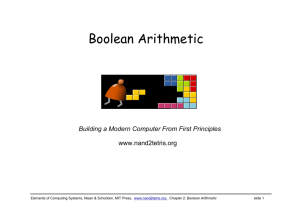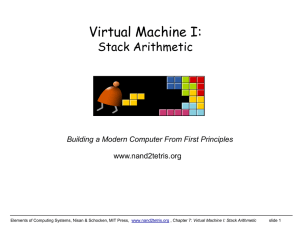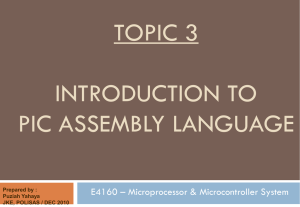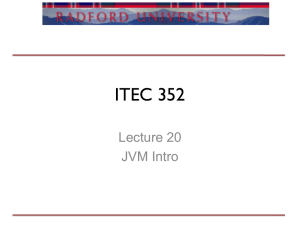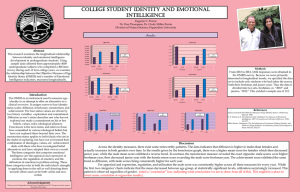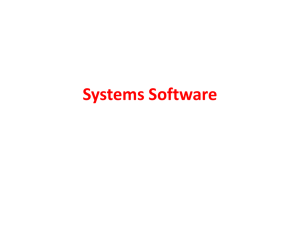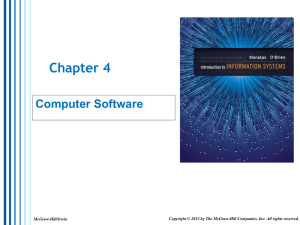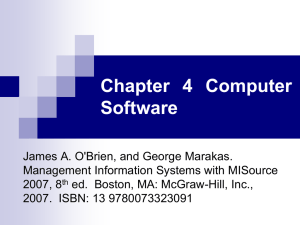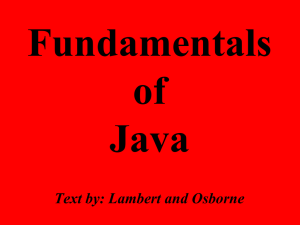lecture 06 assembler
advertisement
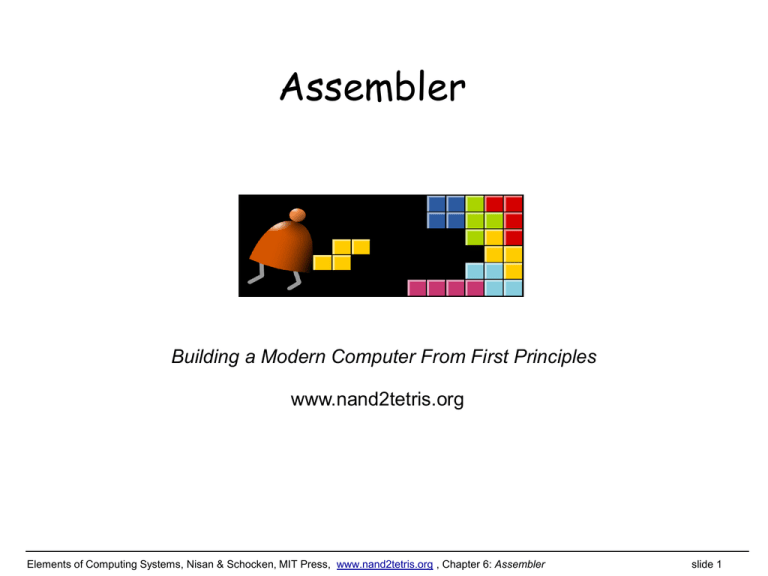
Assembler Building a Modern Computer From First Principles www.nand2tetris.org Elements of Computing Systems, Nisan & Schocken, MIT Press, www.nand2tetris.org , Chapter 6: Assembler slide 1 Usage and Copyright Notice: Copyright © Noam Nisan and Shimon Schocken This presentation contains lecture materials that accompany the textbook “The Elements of Computing Systems” by Noam Nisan & Shimon Schocken, MIT Press, 2005. We provide both PPT and PDF versions. Our web site, www.nand2tetris.org ,features a set of presentations, one for each book chapter. Each presentation is designed to support about 3 hours of classroom or self-study instruction. You are welcome to use or edit this presentation as you see fit for instructional and noncommercial purposes. If you use our materials, please include a reference to www.nand2tetris.org If you have any questions or comments, please write us at nand2tetris@gmail.com Elements of Computing Systems, Nisan & Schocken, MIT Press, www.nand2tetris.org , Chapter 6: Assembler slide 2 Where we are at: Human Thought Abstract design Software hierarchy abstract interface Chapters 9, 12 H.L. Language & Operating Sys. Compiler abstract interface Chapters 10 - 11 Virtual Machine VM Translator abstract interface Chapters 7 - 8 Assembly Language Assembler Chapter 6 abstract interface Machine Language Computer Architecture abstract interface Chapters 4 - 5 Hardware Platform Hardware hierarchy Gate Logic abstract interface Chapters 1 - 3 Chips & Logic Gates Elements of Computing Systems, Nisan & Schocken, MIT Press, www.nand2tetris.org , Chapter 6: Assembler Electrical Engineering Physics slide 3 Why care about assemblers? Because … Assemblers employ nifty programming tricks Assemblers are the first rung up the software hierarchy ladder An assembler is a translator of a simple language Writing an assembler = low-impact practice for writing compilers. Elements of Computing Systems, Nisan & Schocken, MIT Press, www.nand2tetris.org , Chapter 6: Assembler slide 4 Program translation (for illustration purposes, this is not the Hack language) Target code Source code Translator The program translation challenge Extract the semantics from the source program, using the syntax rules of the source language Express the program’s semantics in the target language, using the syntax rules of the target language Assembler = simple translator Translates each assembly command into one or more machine instructions Handles symbols (i, sum, LOOP, END, …). Elements of Computing Systems, Nisan & Schocken, MIT Press, www.nand2tetris.org , Chapter 6: Assembler slide 5 Symbol resolution (for illustration purposes, this is not the Hack language) In low level languages, symbols are used to code: Variable names Destinations of goto commands (labels) Special memory locations This example is based on some simplifying assumptions: Each command fits into one memory location Each variable fits into one memory location The assembly process: First pass: construct a symbol table Second pass: translate the program, using the symbol table for symbols resolution. These assumptions can be relaxed easily. Elements of Computing Systems, Nisan & Schocken, MIT Press, www.nand2tetris.org , Chapter 6: Assembler slide 6 The Hack assembly language Assembly program (Prog.asm) // Adds 1 + ... + 100 @i M=1 // i=1 @sum M=0 // sum=0 (LOOP) @i D=M // D=i @100 D=D-A // D=i-100 @END D;JGT // if (i-100)>0 goto END @i D=M // D=i @sum M=D+M // sum=sum+i @i M=M+1 // i=i+1 @LOOP 0;JMP // goto LOOP (END) @END 0;JMP // infinite loop Assembly program = a stream of text lines, each being one of the following: Instruction: A-instruction or C-instruction Symbol declaration: (symbol) Comment or white space: // comment. Elements of Computing Systems, Nisan & Schocken, MIT Press, www.nand2tetris.org , Chapter 6: Assembler slide 7 Handling A-instructions Symbolic: @value // Where value is either a non-negative decimal number // or a symbol referring to such number. value (v = 0 or 1) Binary: 0 v v v v v v v v v v v v v v v Translation to binary: If value is a number: simple If value is a symbol: later. Elements of Computing Systems, Nisan & Schocken, MIT Press, www.nand2tetris.org , Chapter 6: Assembler slide 8 Handling C-instruction Symbolic: dest=comp;jump // Either the dest or jump fields may be empty. // If dest is empty, the "=" is ommitted; // If jump is empty, the ";" is omitted. comp Binary: 1 1 1 a c1 c2 c3 c4 dest c5 c6 d1 d2 jump d3 j1 j2 j3 Translation to binary: simple! Elements of Computing Systems, Nisan & Schocken, MIT Press, www.nand2tetris.org , Chapter 6: Assembler slide 9 The overall assembly logic Assembly program (Prog.asm) // Adds 1 + ... + 100 @i M=1 // i=1 @sum M=0 // sum=0 (LOOP) @i D=M // D=i @100 D=D-A // D=i-100 @END D;JGT // if (i-100)>0 goto END @i D=M // D=i @sum M=D+M // sum=sum+i @i M=M+1 // i=i+1 @LOOP 0;JMP // goto LOOP (END) @END 0;JMP // infinite loop For each (real) command Parse the command, i.e. break it into its constituent fields Replace each symbolic reference (if any) with the corresponding memory address (a binary number) For each field, generate the corresponding binary code Assemble the binary codes into a complete machine instruction (16-bit code). Elements of Computing Systems, Nisan & Schocken, MIT Press, www.nand2tetris.org , Chapter 6: Assembler slide 10 Symbols handling (in the Hack language) Program example // Adds 1 + ... + 100 @i M=1 // i=1 @sum M=0 // sum=0 (LOOP) @i D=M // D=i @100 D=D-A // D=i-100 @END D;JGT // if (i-100)>0 goto END @i D=M // D=i @sum M=D+M // sum=sum+i @i M=M+1 // i=i+1 @LOOP 0;JMP // goto LOOP (END) @END 0;JMP // infinite loop Predefined symbols: (don’t appear in this example) Label symbols: The pseudo-command (label) declares that the user-defined symbol label should refer to the memory location holding the next command in the program Variable symbols: In a @label command, if label is neither a predefined symbol, nor a symbol defined elsewhere in the program using the (label) pseudo command, then label is treated as a variable Design decision: variables are mapped to consecutive memory locations starting at RAM address 16. Elements of Computing Systems, Nisan & Schocken, MIT Press, www.nand2tetris.org , Chapter 6: Assembler slide 11 Example Assembly code (Prog.asm) // Adds 1 + ... + 100 @i M=1 // i=1 @sum M=0 // sum=0 (LOOP) @i D=M // D=i Assembler @100 D=D-A // D=i-100 @END D;JGT // if (i-100)>0 goto END @i D=M // D=i @sum M=D+M // sum=sum+i @i M=M+1 // i=i+1 @LOOP 0;JMP // goto LOOP (END) @END 0;JMP // infinite loop Binary code (Prog.hack) (this line should be erased) 0000 0000 0001 0000 1110 1111 1100 1000 0000 0000 0001 0001 1110 1010 1000 1000 (this line should be erased) 0000 0000 0001 0000 1111 1100 0001 0000 0000 0000 0110 0100 1110 0100 1101 0000 0000 0000 0001 0010 1110 0011 0000 0001 0000 0000 0001 0000 1111 1100 0001 0000 0000 0000 0001 0001 1111 0000 1000 1000 0000 0000 0001 0000 1111 1101 1100 1000 0000 0000 0000 0100 1110 1010 1000 0111 (this line should be erased) 0000 0000 0001 0010 1110 1010 1000 0111 Elements of Computing Systems, Nisan & Schocken, MIT Press, www.nand2tetris.org , Chapter 6: Assembler slide 12 Proposed implementation An assembler program can be designed as follows. Software modules: Parser: Unpacks each command into its underlying fields Code: Translates each field into its corresponding binary value, and assembles the result SymbolTable: Manages the symbol table Main: Initializes I/O files and drives the show. Proposed implementation stages Stage I: Build a basic assembler for programs with no symbols Stage II: Extend the basic assembler with symbol handling capabilities. Elements of Computing Systems, Nisan & Schocken, MIT Press, www.nand2tetris.org , Chapter 6: Assembler slide 13 Parser module Elements of Computing Systems, Nisan & Schocken, MIT Press, www.nand2tetris.org , Chapter 6: Assembler slide 14 Parser module (cont.) Elements of Computing Systems, Nisan & Schocken, MIT Press, www.nand2tetris.org , Chapter 6: Assembler slide 15 Code module Elements of Computing Systems, Nisan & Schocken, MIT Press, www.nand2tetris.org , Chapter 6: Assembler slide 16 Building the final Hack assembler Initialization: create the symbol table and initialize it with the pre-defined symbols First pass: march through the source program without generating any code. For each label declaration “(label)”, add the pair <label,n > to the symbol table Second pass: march again through the program, and translate each line: If the line is a C-instruction, simple If the line is “@label” where label is a number, simple If the line is “@label” and label is a symbol, look it up in the symbol table and proceed as follows: If the symbol is found, replace it with its numeric meaning and complete the command’s translation If the symbol is not found, then it must represent a new variable: add the pair <label,n > to the symbol table, where n is the next available RAM address, and complete the command’s translation. (The allocated RAM addresses are running, starting at address 16). Elements of Computing Systems, Nisan & Schocken, MIT Press, www.nand2tetris.org , Chapter 6: Assembler slide 17 Symbol table Elements of Computing Systems, Nisan & Schocken, MIT Press, www.nand2tetris.org , Chapter 6: Assembler slide 18 Perspective Simple machine language, simple assembler Most assemblers are not stand-alone, but rather encapsulated in a translator of a higher order C programming (e.g. for real-time systems) may involve re-writing critical segments in assembly, for optimization C programmers that understand the code generated by a C compiler can improve their code considerably Macro assemblers: Elements of Computing Systems, Nisan & Schocken, MIT Press, www.nand2tetris.org , Chapter 6: Assembler slide 19
